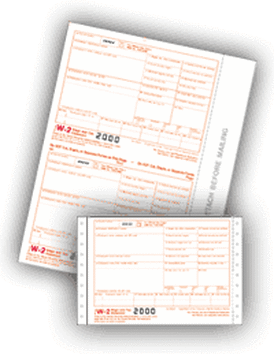TAX FORMS - W2's AND 1099's
Download our 2016 Tax Forms Catalog
|
| ||||||
W2s and 1099s

W-2, Wage and Tax Statement, is used to report wages paid to employees and the taxes withheld from them. Employers must complete a Form W-2 for each employee to whom they pay a salary, wage, or other compensation as part of the employment relationship. An employer must mail out the Form W-2 to employees on or before January 31. This deadline gives these taxpayers about 2½ months to prepare their returns before the April 15 income tax due date. The form is also used to report FICA taxes to the Social Security Administration. The Form W-2, along with Form W-3, generally must be filed by the employer with the Social Security Administration by the end of February. Relevant amounts on Form W-2 are reported by the Social Security Administration to the Internal Revenue Service. In territories, the W-2 is issued with a two letter code indicating which territory, such as W-2GU for Guam. If corrections are made, it can be done on a W-2c.
The 1099 form series is used to report various types of income other than wages, salaries, and tips (for which Form W-2 is used instead). Examples of reportable transactions are amounts paid to a non-corporate independent contractor for services (in IRS terminology, such payments are nonemployee compensation). The ubiquity of the form has also led to use of the phrase "1099" to refer to the independent contractors themselves. In 2011 the requirement has been extended by the Small Business Jobs Act of 2010 to payments made by persons who receive income from rental property.
Each payer must complete a Form 1099 for each covered transaction. Four copies are made: one for the payer, one for the payee, one for the IRS, and one for the State Tax Department, if required.[7] Payers who file 250 or more Form 1099 reports must file all of them electronically with the IRS.[8] If the fewer than 250 requirement is met, and paper copies are filed, the IRS also requires the payer to submit a copy of Form 1096, which is a summary of information forms being sent to the IRS. The returns must be filed with the IRS by the end of February immediately following the year for which the income items or other proceeds are paid. Copies of the returns must be sent to payees, however, by the end of January. The law provides various dollar amounts under which no Form 1099 reporting requirement is imposed. For some Form 1099s, for example, no filing is required for payees who receive less than $600 from the payer during the applicable year.
The 1099 form series is used to report various types of income other than wages, salaries, and tips (for which Form W-2 is used instead). Examples of reportable transactions are amounts paid to a non-corporate independent contractor for services (in IRS terminology, such payments are nonemployee compensation). The ubiquity of the form has also led to use of the phrase "1099" to refer to the independent contractors themselves. In 2011 the requirement has been extended by the Small Business Jobs Act of 2010 to payments made by persons who receive income from rental property.
Each payer must complete a Form 1099 for each covered transaction. Four copies are made: one for the payer, one for the payee, one for the IRS, and one for the State Tax Department, if required.[7] Payers who file 250 or more Form 1099 reports must file all of them electronically with the IRS.[8] If the fewer than 250 requirement is met, and paper copies are filed, the IRS also requires the payer to submit a copy of Form 1096, which is a summary of information forms being sent to the IRS. The returns must be filed with the IRS by the end of February immediately following the year for which the income items or other proceeds are paid. Copies of the returns must be sent to payees, however, by the end of January. The law provides various dollar amounts under which no Form 1099 reporting requirement is imposed. For some Form 1099s, for example, no filing is required for payees who receive less than $600 from the payer during the applicable year.
|
Variants for Form 1099
Several versions of Form 1099 are used, depending on the nature of the income transaction:
|

